19th Century
In the 1820s Indiana Avenue was not much more than a dirt path that existed in cartographical imagination more than as a central thoroughfare, and it would mostly stand empty into the middle of the 19th century. Prior to the 1850s the undeveloped land on the city’s northwest side was often used for horse races that “took place nearly every Saturday, and were usually decorated with a fight or two,” according to Barry R. Sulgrove. Indianapolis grew slowly until the 1850s. Indiana’s largest cities were New Albany and Madison, where the Ohio River facilitated trade. In Indianapolis, the White River was unnavigable, and the planned Central Canal failed in 1839. While the newly built National Road (Washington Street) provided a slightly improved artery for trade, there simply was no reliable way to bring goods to the city or transport them to external markets. During this period W. R. Holloway noted that “business was entirely of a local character. . . Manufacturing was merely for home consumption.”
Early European settlers
Some of the city’s earliest European settlers farmed along the northwestern reaches of Indiana Avenue and operated mills on the tributaries of Fall Creek. One such miller was Isaac Wilson, a Revolutionary War veteran and ancestor of Hoosier poet James Whitcomb Riley. The waterways that powered the mills also contributed to flooding and probably disease. Laura Fletcher Hodges’ Early Indianapolis indicated that “there were frequent heavy rains and the water stood for months in the low spots of the ravines which traversed the town. Malarial diseases followed.” In 1921 the Indianapolis Star reported that the former Wilson home still stood on the site of Riley Memorial Hospital. The homestead still contained “the grave of that stalwart settler, Isaac Wilson and his wife Sarah, the only known grave of a revolutionary soldier buried in the city,” which lay in what was known as the “plague burying ground” into the 1950s.
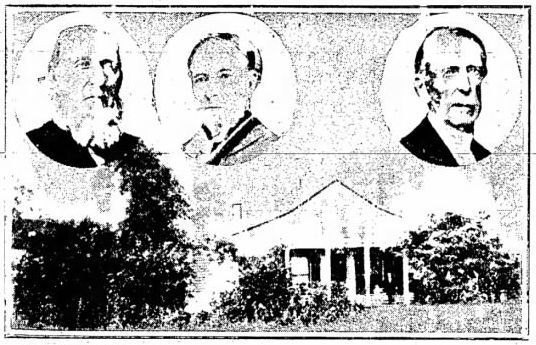
Railroads and industry
Perhaps the city’s most profound material and social transformations came when a series of railroad lines converged on Indianapolis. The city’s first rail connection was built in 1847, and by 1854 seven rail lines connected Indianapolis to other markets. These arteries would become well-situated industrial locations quite rapidly in the 1855-1875 period, and residential neighborhoods surrounding these industrial workplaces would grow at the same moment. Around the middle of the 19th century, residents began to settle outside the Mile Square.
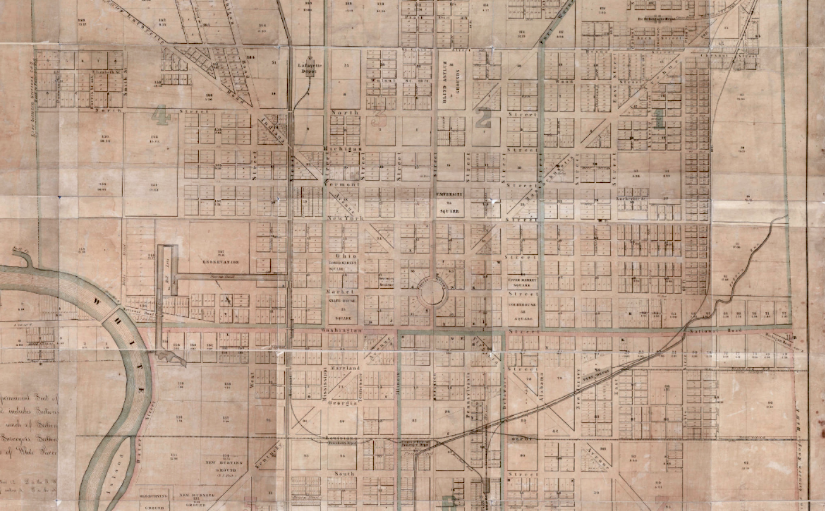
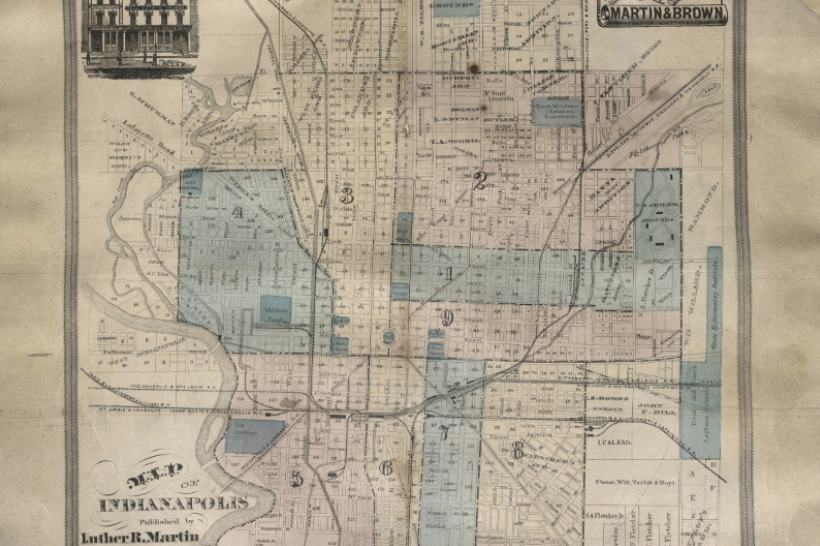
Some development along Indiana Avenue’s western reaches came during the construction of City Hospital. Antebellum municipal hospitals were relatively uncommon institutions outside of major cities, and they almost exclusively treated the indigent. The hospital was first proposed in Indianapolis by the Board of Health in 1833 and again during a smallpox epidemic in 1847, but the idea was rejected as too expensive in both cases. Nevertheless, property for the City Hospital was purchased in March 1855, and construction on City Hospital finally began in 1857. Residents remained reluctant to receive health care in hospitals rather than homes, though, and in October 1859 the incomplete building still needed a roof. It stood empty when wounded soldiers began to be treated at the hospital by May 1861, and in March 1862 the City Council agreed the Union Army could manage the hospital “so long as the rebellion exists.” The Army returned the hospital to the city in July 1866, at a moment when the city’s population would expand as newcomers migrated to Indianapolis, and many of these migrants would find homes in the neighborhoods along Indiana Avenue.

Retailers, grocers, and saloons
Indiana Avenue is known as an African American cultural hub in the 20th century, but in the 19th century white Hoosiers, European immigrants, and African American residents alike started enterprises along Indiana Avenue. Initially, grocers and craftspeople served the farmers who came into the city on Indiana Avenue. David Burkhart, for instance, came to Indianapolis in about 1824 and founded a grocery serving residents and travelers on Indiana Avenue. Jacob Piatt Dunn in 1910 referred to Burkhart’s establishment as a “groggery grocery” that trafficked in household provisions as well as alcohol, and Dunn suggested that the store “was headquarters for a collection of rough characters.” In 1855 Irish immigrant Richard Cook had established a butcher shop on Indiana Avenue, and in 1858 the Daily Sentinel enthused over the “Magnificent Beef, Mutton, Veal, Lamb, &c. … at the meat store of Mr. Richard Cook.” The 1858 city directory identified eight groceries, two physicians’ offices, a boot shop, ice dealer, and carpenter’s shop on Indiana Avenue, revealing the street rapidly was becoming a retail district.
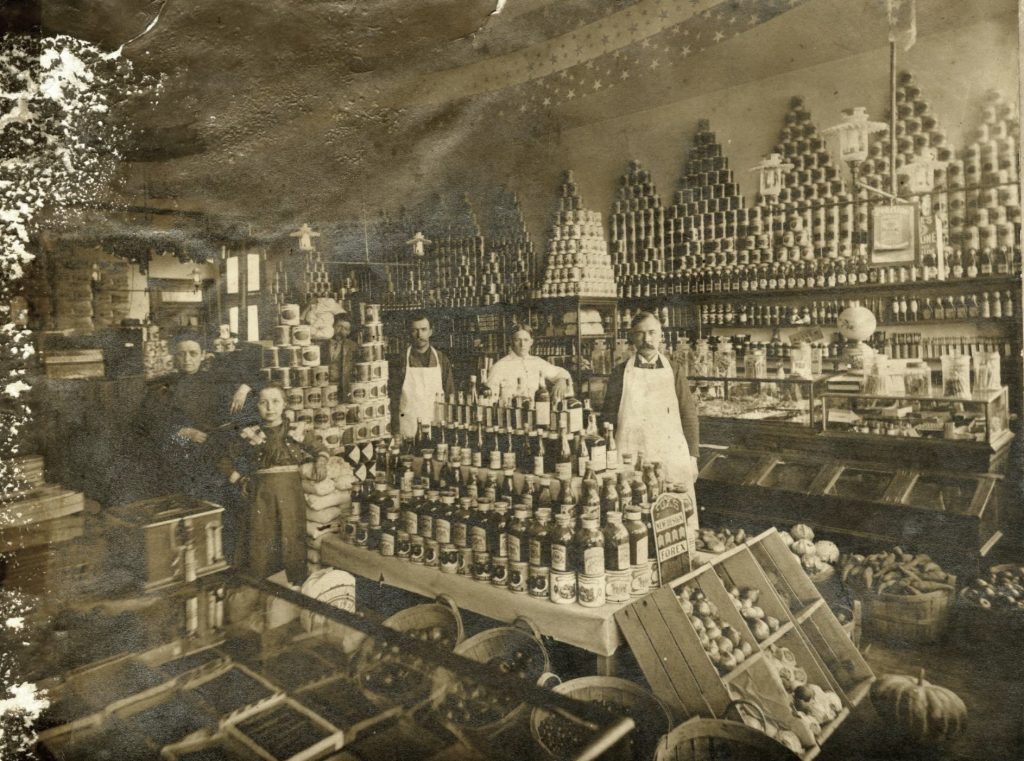
Among the first grocery stores on Indiana Avenue were several of the city’s first African American businesses. In October 1863 two African American residents, Nancy Bushrod and Samuel G. Smothers, married and established a grocery store. Nancy Smothers eventually opened a restaurant in this location, and her daughter later assumed management of the restaurant, popularly known as the “Beanery.” In November 1913 Nancy Smothers opened the Pioneer Theater at 513 Indiana Avenue alongside the restaurant. Smothers died in September 1915, and when her estate was assessed in probate court the properties she and her husband purchased in 1865 were reportedly valued at $20,000 (nearly $323,000 in 2021).
By 1870 Indiana Avenue looked less like a frontier town and more like part of an emerging city. While craftspeople would continue to work along the Avenue, an increasingly broad range of retail spaces opened in the 1870s. German immigrants Leonhard Schurr and his son Leonhard Schurr Jr. opened a watchmaker’s shop in the 300 block in about 1870, and after his father’s death in 1885 Leonhard Jr. managed the shop until his death in 1906. In 1865 John Gahm opened perhaps the first saloon on the Avenue. George Biersdoerfer opened the Great Western Saloon at the corner of Indiana Avenue and Illinois Street in May 1868, and the saloon landscape would grow quite rapidly afterward. By 1899 there were 21 saloons on Indiana Avenue.

☙
Segregating the Avenue
Before the Civil War, Indiana Avenue’s population was similar to the city overall. Residents included East Coast newcomers, European immigrants, and a handful of African Americans. This contrasts with the predominately African American community that would be living and conducting business along the Avenue beginning in the early 20th century. That transformation began after the Civil War and accelerated at the very end of the 19th century.
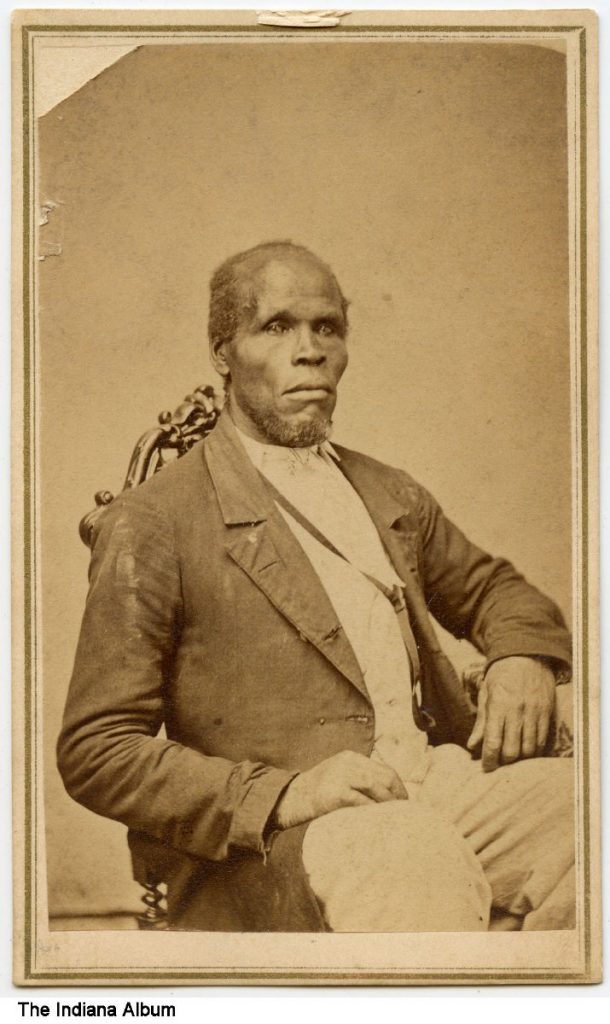
There were few African American residents in Indianapolis in 1850, primarily because this population was suppressed by newly introduced fugitive slave laws. In June 1853, for instance, Indianapolis resident John Freeman was arrested by a Missouri slaveholder claiming Freeman as an escaped captive. Freeman was the wealthiest African American in the modest capital city, and he was jailed for 68 days and compelled to launch a vigorous defense establishing that he had been emancipated in Virginia in 1831. Threats like this caused some African American residents to avoid or leave Indiana.
Indianapolis grew quickly after the Civil War, from 48,200 residents in the 1870 census to 75,000 residents in 1880. The Black population in Indianapolis grew by 122 percent in the 1870s, and by 1880 Black residents numbered 6,000, or 8 percent of the city’s population. This rapid growth rate was fueled by postwar Southern migration, and many of these newcomers settled in the city’s near westside.
In the 1880 census, there were 682 individuals living on Indiana Avenue. The most common race and place of ancestry were white residents born in Indiana. There were 80 residents who immigrated from other countries, most often Germany and Ireland. There were 115 people who were identified as Black or Mulatto, and most were from the Upper South. These residents would have found a growing African American community in the neighborhoods that extended off of Indiana Avenue. At that time, though, these neighborhoods were not particularly segregated, and Black and white residents often lived as neighbors.
By the end of the 19th century, the population along Indiana Avenue had swelled to 1,017. Most of the residents (69 percent) were white, but the growing Black community made up 30 percent of the population. Between 1880 and 1920 the city’s population grew more than four-fold, and in 1920, Black residents made 77 percent of the Avenue’s residential population. The percentage of Black residents in 1880 had been just less than 17 percent, but in 1900 it was almost one-third. There was clearly an African American community along the Avenue that was gradually growing and becoming somewhat more segregated. The Avenue was a predominately African American marketing and residential district by 1920, but one-quarter of the residents with an Indiana Avenue address still were identified as white in the census. For example, in 1920 the 900 block was 68 percent white. Nevertheless, in the second quarter of the 20th century the city and Indiana Avenue became more sharply segregated along the color line, mirroring Indianapolis’ embrace of de facto segregation. The neighborhood had become an overwhelmingly Black, segregated community.
Indiana’s African American population grew quickly after the Civil War
Percentage change in African American residents during the previous decade
☙
Underground Economy
A reputation for vice
In November 1909 the Indianapolis Recorder painted Indiana Avenue as a vice-ridden neighborhood when it complained that “Indiana Avenue, one of the most promising thoroughfares in this city, is commercially dead, simply because of the presence and notorious conduct of its dives run by colored men and its barrel houses run by white men.” Such rhetoric was common at the time: white ideologues deplored vice as an excuse to rationalize segregation, while African American ideologues championing bourgeois discipline condemned vice for slowing African American citizen rights. Gambling, violence, and prostitution were certainly not unique to Indiana Avenue, but they punctuated life along Indiana Avenue for a century. In a society in which opportunity was systematically denied to African Americans, entrepreneurship in vice industries at the margins of the law shaped the fortunes of many of the most prominent personalities who lived and worked along the Avenue.
The Avenue’s reputation for criminality and immorality was being constructed in the wake of the Civil War. In November 1878, for instance, the Indianapolis News had suggested that “the folly of sending missionaries abroad while so much need of regeneration exists at home, can be demonstrated to anyone who will take a walk out Indiana avenue any fine Sunday afternoon.” Most of this early criticism of Avenue life came from a host of anti-saloon and temperance crusaders who emerged in antebellum Indiana and were a public force throughout post-Civil War Indianapolis.
Saloons and political organizing
Saloons emerged on the Avenue by the end of the Civil War, and by 1914 there were 33 saloons on Indiana Avenue. Objection to saloons reflected the growth of a nationwide temperance movement. Archie Greathouse, for instance, was a common target of anti-saloon activism. He was one of the first African American saloon proprietors on the Avenue, operating saloons and restaurants there from the 1880s until his death in 1936. Neighbors petitioned against Greathouse’s application for a liquor license in December 1889, but County Commissioners rejected the remonstrance.
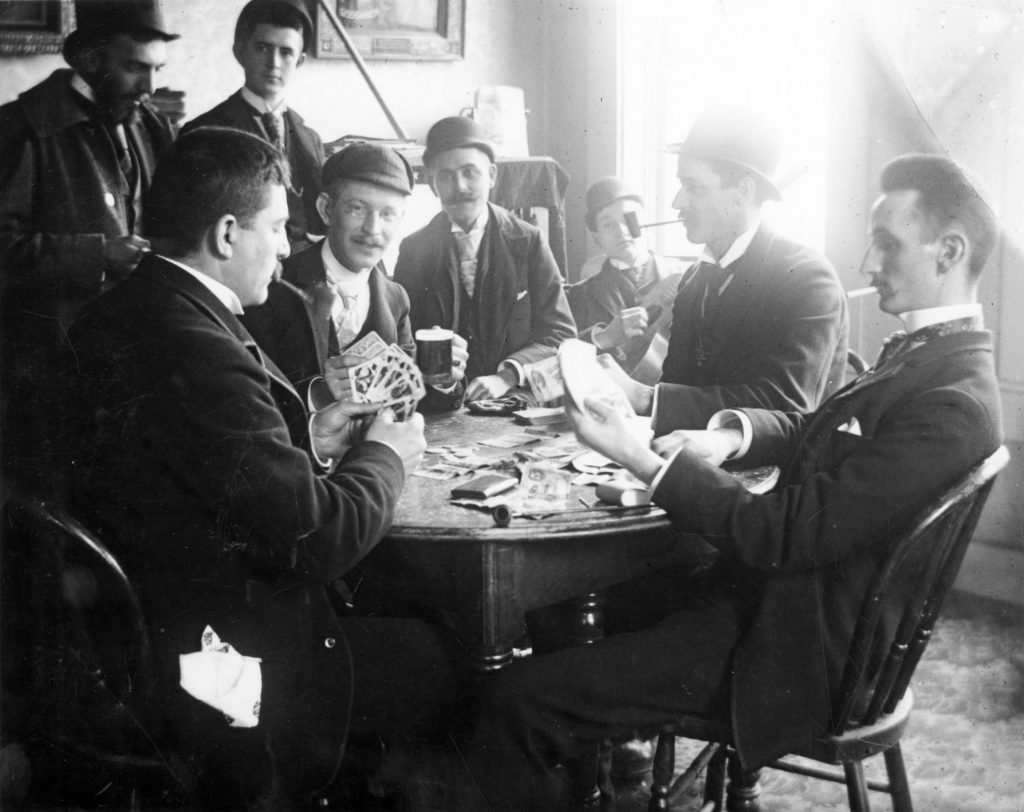
Like many saloon keepers, Greathouse lorded over alcohol sales, orchestrated gambling, and supervised or at least permitted a host of minor vices that would make him a common target of moralists for more than a half-century. In June 1895, for example, a man was murdered during a dice game in Greathouse’s saloon. In September police raided Greathouse’s saloon and arrested eight African Americans who were gambling. A year later one of Greathouse’s barkeepers shot at a man in the saloon, and the Indianapolis Journal noted that “The place is owned by Archie Greathouse and the customers are nearly all colored people of the neighborhood.” When Prohibition began, Greathouse’s saloon followed a common pattern of city saloons and became a “soft drink parlor.” In a 1919 tour for British delegates and temperance advocates, Greathouse’s saloon was even featured as one of many “business-buildings formerly occupied by saloons.”
White ideologues were wary of saloons because they were places African Americans organized politically. In July 1900, for instance, the “Iron League” formed in the 500 block of Indiana Avenue. The African American Republican group organized for Republican candidates, lobbied against voting fraud, and met and made statements on civil rights violations like a 1901 lynching in Terre Haute. Archie Greathouse would follow in this saloon activism tradition, becoming one of the most prominent activists opposing the segregation of Indianapolis high schools in the early 1920s. Greathouse funded lawsuits to oppose the segregation of high schools, which eventually ended in the creation of Crispus Attucks High School.
Police surveillance was often an attack on this political activism. In December 1902, for example, the Indianapolis Journal reported that Avenue “Patrolman Frank Bolen declared war on the negroes on Indiana avenue … Bolen succeeded in arresting eight negroes, whom he charged with loitering.” Most were unable to pay loitering fines and, according to the Indianapolis News, they “were sent to the workhouse in default of payment.”
Gambling and gaming
Gambling activities like numbers games, pea shake, and craps were used by ideologues to define the Avenue as a liminal, if not “immoral” place. Gambling was a staple of all 19th-century saloons, and dice, billiards, numbers games, and pools were common in Avenue venues long into the 20th century. Gaming took an enormously broad range of forms. Baseball pools, for instance, flourished in Indianapolis and along the Avenue for much of the 20th century.
Gambling on baseball had begun in Indianapolis by the late 19th century, and in 1917 William Thomas Brown was arrested for selling baseball pool tickets from his cigar store in the 200 block of Indiana Avenue. Raids on baseball pools throughout the city invariably ended with arrests on Indiana Avenue, including cases in April 1923 (where a soda parlor was also selling liquor in violation of Prohibition laws), April 1924, July 1924, and June 1925, and baseball pool gambling would continue into the 21st century in some reaches of the city. Since 2019 sports betting has been legalized in Indiana.
Entrepreneurship and tycoons
A handful of Avenue entrepreneurs built lifelong empires that revolved around gambling and a host of minor vices. Brothers Joe and Isaac “Tuffy” Mitchell were Russian immigrants who managed saloons, restaurants, and poolrooms. In 1950 the Indianapolis Times suggested Mitchell had been arrested 27 times, but a year later another estimate put that total at 40 arrests. Mitchell also began managing local musicians in the late 1950s and operated Tuff Record Company. He was arrested repeatedly until his death in 1970 when he was out on bail.
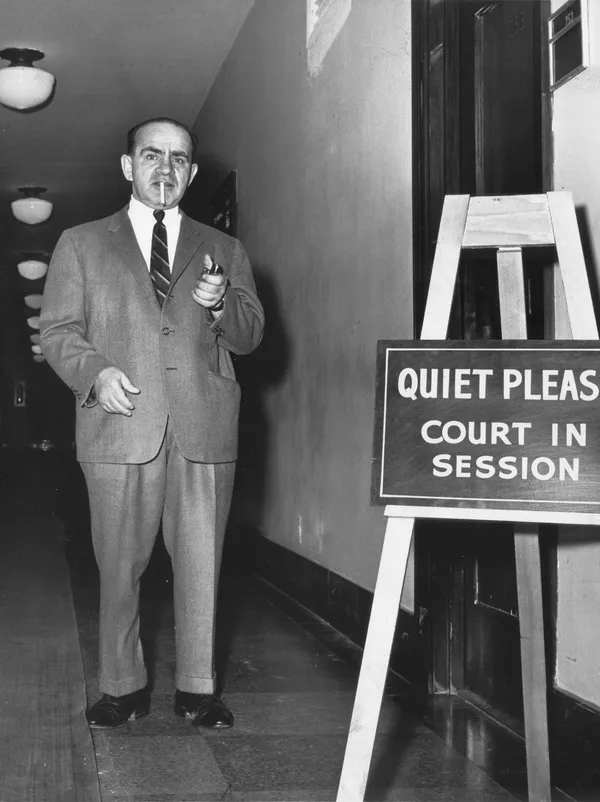
Harry “Goosie” Lee was born in Tennessee in 1893 and came to Indianapolis with his parents in about 1902. Lee was known for African American Republican party activism along Indiana Avenue and was working as a bondsman by January 1920, when he was arrested for having 17 one-gallon jugs of whisky in his car. His Avenue venues were constantly raided throughout the 1920s, but Lee maneuvered out of any significant prison sentences. In July 1928, for instance, his Hollywood Café in the 500 block of Indiana Avenue was raided as a suspected “blind tiger,” but the charges were dismissed when it was acknowledged that the police did not have a search warrant.
Archie “Joker” Young managed businesses along Indiana Avenue for a half-century, all of them deeply involved in a gambling trade that would leave Young with a long arrest record. By one estimate at his death in 1952 Young had been arrested 34 times since 1912. Like Goosie Lee, Sol Caldwell was a prominent Republican activist, and in 1920 Democrats complained that Caldwell’s continuous arrests without conviction reflected Mayor Charles W. Jewett’s protection of the African American vote. In August 1920 the Indianapolis Times sarcastically complained that “Sol Caldwell ought to be entitled to immunity from arrest by this time. He has been so successful in conducting his gambling house on Indiana Avenue that it ought to be apparent to every member of the police department that he has earned the privilege of gambling unmolested.”
Prohibition provided a new and very profitable trade for some Avenue entrepreneurs. The Indianapolis Times suggested in 1920 that “there are numerous bootleggers on `De Av’noo,’ who generally ask the purchaser to walk into an alley, a stairway, or into a side street before selling the whisky.” In June 1920 the police announced the creation of a new “morals squad” that would ambitiously take aim on “gamblers, would-be gamblers, bootleggers, and women of the underworld.” The squad visited the most prominent Avenue outlets with a history of vice arrests, including Goosie Lee, Archie Young, Sol Caldwell, West Alexander, and William Butler.
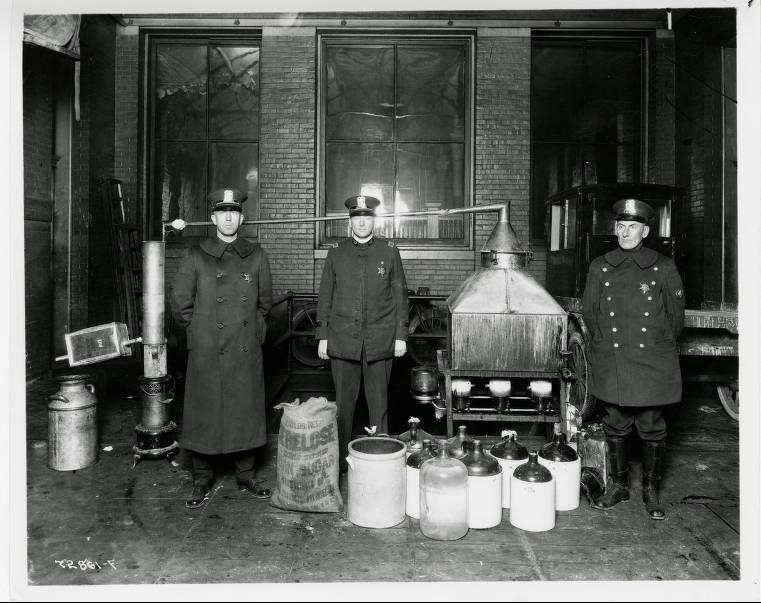
☙
Expressive culture
Earliest performers
Music, dance, and theater were always part of everyday Hoosier life and leisure. Indiana Avenue is fabled as a center of African American expressive culture in the 20th century, including theater, song, dance, comedy, drag, and cinema. Postwar jazz has secured the most attention, but an enormously broad range of music was played along the Avenue beside a stunning breadth of African American performances.
In 1860 the census identified perhaps the first professional musician living on Indiana Avenue. New York-born Edward Hines was living in the 300 block of Indiana Avenue, where a year later the city directory identified him as a “Professor of music and dancing.” Hines would be among a legion of music teachers in the near westside over more than 150 years, and he was among many white Hoosiers and European immigrants who were performers in the late 19th and early 20th centuries. Some of these musicians worked and performed along Indiana Avenue in the 19th century, but by the early 20th century performance spaces along the Avenue were quite strictly segregated for both performers and audiences alike.
Performance found its first public foothold in saloons along Indiana Avenue during the Civil War, and like most saloon culture these venues were often the target of moral surveillance. Music, dance, theater, and performances like sports and freak shows would find a home in these saloons in the 19th century.
A few musicians lived on Indiana Avenue as early as the 1880s. Henry Monninger, for instance, was born in Indiana in 1856 to German immigrant parents. His father ran a saloon on the Avenue, and Henry was listed in the 1880 census as one of three musicians living on Indiana Avenue. George Temple was an African American performer who lived just south of the Avenue and was identified as an actor, comedian, and minstrel in census records. Those labels described typical skills of the earliest generation of African American performers, who were building a Black vaudeville tradition in which men and women were musicians, dancers, actors, and comedians; they were fluent in opera, religious, ragtime, and popular music alike and might play risqué comedy, Blackface minstrelsy, or drag.
Vaudeville and minstrelsy
Blackface minstrelsy emerged in the second quarter of the 19th century and was enormously popular in the middle of the century when the performers were white men performing in blackened cork. George Temple’s appearance in the 1894 directory as a minstrel indicates that he was likely performing much of the time in Blackface, which was a staple of turn-of-the-century vaudeville. In May 1897 Temple performed in Blackface in a mixed white and Black cast in a show at Indianapolis’ Empire Theater, and African American performers would appropriate minstrelsy long after it had fallen into disfavor with white audiences.
George Temple would continue playing in traveling minstrel acts and vaudeville shows, such as R. M. Harvey’s Greater Minstrels. Traveling companies of African American performers played theatres and halls after the Civil War and into the late 19th century. In the early 20th century many white theater owners in the Jim Crow South refused to book Black acts, so those African American troupes toured in tent shows that persisted in much of the South into the 1940s. These tent shows introduced white audiences to African American performance, provided entertainment otherwise inaccessible to many African Americans, and served as the training grounds for many of Indiana Avenue’s earliest performers.
In January 1907 George Temple had returned to Indianapolis, when the Indianapolis Recorder reported that “George Temple, the famous comedian, is off the road and is preparing to give `Uncle Tom’s Cabin’ here in the City.” In 1909 Temple appeared in a “cakewalk” contest at Indianapolis’ Tomlinson Hall. The cakewalk was an improvisational dance contest that became popular in the 1870s as an over-exaggerated parody of white formal behavior.
Source: Library of Congress
The Indianapolis Star indicated that in his 1909 Indianapolis show Temple “essayed a woman’s role”; that is, Temple performed in drag. Cross-dressing was a staple of the vaudeville stage and common on Indiana Avenue from the turn of the century onward. In March 1911, for instance, the Indianapolis Recorder reported that “One of the surprises of the Sumner League Minstrels will be the appearance of Clarence Dunlop in the role of female impersonator.” A male impersonator graced the stage of the Crown Garden in 1912 when Mattie Whitman was part of a stage show.
African American performance sought to create the appearance of “authentic” Blackness by reproducing and carefully ridiculing racist caricatures. These turn-of-the-century “coon shows” flourished because of what Lynn Abbott and Doug Seroff call a “cunning amalgam of appreciation and mockery”: shows reassured white audiences and allowed them to furtively embrace African American music and performance. Harry Fiddler, for instance, became a nationally known performer in the 1890s for his Chinese impersonations and performed alongside Indianapolis native Ruben “Ruby” Shelton after about 1907. In 1909 the African American Indianapolis newspaper The Freeman celebrated Fiddler’s talents by arguing that his “Chinese character … would easily be mistaken for the real thing.” Reducing such performances simply to the reproduction of racist caricatures hazards ignoring the limited creative options afforded African Americans on white stages. Nevertheless, the “coon show” and much of African American vaudeville played off racist stereotypes in ways that many African Americans found demeaning.
Theaters and clubs
African American performance halls emerged along Indiana Avenue in the first decade of the 20th century, a moment that was simultaneous with the early waves of Southern migration, increasing segregation, and the arrival of motion pictures. In May 1910 the Freeman reported that African American Indianapolis had three theaters: the Airdome Theater at 523 Indiana Avenue; the Columbia Theater at 524 Indiana Avenue; and the Two Johns Theater at 720 Indiana Avenue.
These theaters typically screened motion pictures, hosted a vast range of vaudeville acts, and rented out space to all sorts of social and community events. Many of these performers were nationally acclaimed artists, and some had connections to the Avenue or would develop them. In October 1916, for instance, the Washington Theater screened their regular motion pictures alongside the vaudeville performers String Beans and Benbow. William Benbow would enjoy a long career as a performer and eventually settle on the Avenue in 1941 and be an influential club owner and manager. Benbow traveled with some of the nation’s best-known performers including Jelly Roll Morton, who indicated that the multi-talented Benbow “would do straight, blackface, dance, sing duets.” In 1906 Morton was part of a group of Benbow’s performers who escaped an attack after a show in Pine Hill, Alabama. Morton observed that “Will Benbow was the kind of fool that never thought anything was the matter that he couldn’t talk his way out of.”
In 1900 the census identified 22 Black/Mulatto musicians in Indianapolis, reflecting that local performance spaces and opportunities for national traveling companies were emerging. Two of those Black musicians were living on Indiana Avenue. John Benton Tolliver was born in Kentucky in 1869 and lived on Indiana Avenue in the 1890’s when he performed in a cakewalk and dance at Tomlinson Hall in 1892.
Four of the 22 African American musicians in the 1900 census for Indianapolis were living in the household of Henry and Sarah Hart, and the Harts and their children were among the most prominent African American performers in the turn-of-the-century city. Born free in Kentucky in 1839, Henry Hart and his family migrated to Cleveland, where he learned to play violin before going to New Orleans in about 1864. In 1874 Hart “organized a negro minstrel company” known as Hart’s Georgia Minstrels, and he was well-known as a composer of popular songs.
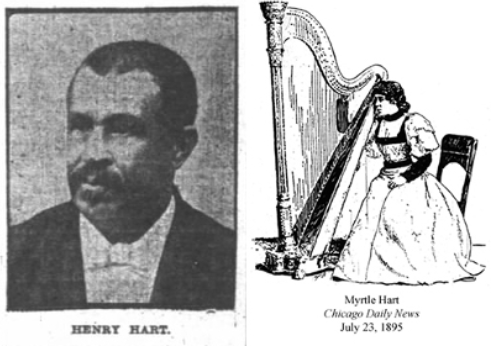
The Indianapolis News reported that Hart and his family had played in Indianapolis for three U.S. presidents’ visits as well as Indiana governors’ inaugurations. He often played for dances, and “what Mr. Hart doesn’t know about Indianapolis society is not at all worth knowing. He is on the most friendly terms with the prominent people of the Hoosier capital.”
Hart and his family were exceptionally gifted musicians who formed an “orchestra” that played a broad range of music. His daughter Myrtle, referred to as “the only colored harpist in the world,” played in the British exhibit at the Chicago World’s Fair. She trained for three years with a Chicago harp teacher. Reportedly Colonel Eli Lilly lent Henry Hart the money in 1893 to purchase Myrtle a harp from an exhibitor at the World’s Fair. Myrtle married Boston conductor William MacKinlay in 1926. Myrtle performed under the stage name Louise Kavanaugh, and she was compelled to pass as white to secure positions in orchestras.
Origins of jazz
Noble Sissle, Reginald DuValle, Russell Smith, and Ben Holliman were among a handful of near westside musicians who would be among the city’s first performers playing something called “jazz.” Among the earliest uses of the term jazz as a musical form came in July 1915. The Chicago Sunday Tribune’s Gordon Seagrove quoted an anonymous Chicago musician who rooted jazz in blues’ heritage, which “started in the south half a century ago and are the interpolations of [Black musicians] originally. The trade name for them is `jazz.’”
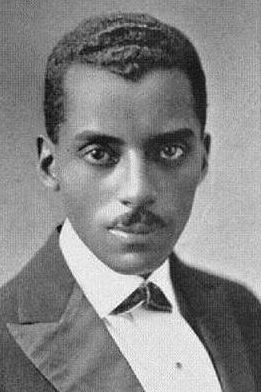
Noble Sissle, shown in 1920, was a pianist, bandleader, and composer. Sissle may have been the best known of these early Indianapolis jazz performers, but he did not perform extensively in Avenue venues, and he would secure his fame on stages beyond Indianapolis.
Credit: New York Public Library View Source
Reginald DuValle was born in Indiana in October 1892 and graduated from Shortridge High School in 1911, and within a year of graduation, he was performing in a dance orchestra with Russell Smith. Smith had published “Microbe Rag” and “That Demon Rag” in 1911, and between 1911 and 1914 Smith’s orchestra served as the first African American orchestra for the Severin Hotel. Ben Holliman was born in Kentucky in 1886 and came to Indianapolis in about 1904. In July 1918 Holliman secured a copyright on the song “The Jungle Society Ball,” and he would perform along the Avenue for a half-century.

Jazz originated from ragtime, spirituals, and blues and had many regionally distinctive expressions, but all observers acknowledged jazz’s indebtedness to African American expression. In 1917, for example, an Indianapolis News report on a traveling African American performance group linked jazz to African American musical traditions. The newspaper reported that the Smart Set would play the Park Theater, featuring “Negro singing, dancing and Jazz music.”
Inter-war period
There was a transformation in performance spaces over roughly three decades between 1920 and 1950. Some vaudeville theaters were converted to movie theaters. In 1922, for instance, there were three moving picture theaters on the Avenue: the Hortense Theater (formerly the Pioneer); the Two Johns; and the Washington (the former Crown Garden). They were joined by the Hill brothers’ Indiana Theater in the 400 block in about 1923.
James and Louis Hill were among the Avenue’s first African American theater owners, purchasing the Columbia Theater in the 500 block of Indiana Avenue in 1910, and following that with the March 1911 purchase of the Senate Theater on nearby Senate Avenue. In 1919 the brothers had renamed the Senate Avenue theater the new Columbia. The Hills’ Indiana Theater primarily showed films, but like many of the early movie theaters they initially continued to host vaudeville shows, had an orchestra, and featured live events like boxing. The theater transitioned entirely to motion pictures in the mid-1920s, and they were advertising talkies by March 1929.
Gradually, the orchestras that had played alongside moving pictures and vaudeville shows were replaced by pipe organ, phonographs, or player pianos. The Indianapolis Recorder recognized this in October 1928 when it reported that “throughout the country there has been a gradual dismissal of musicians from the theatres. The `talkies’ are said to be responsible for this situation.” Radio had rendered music a reproducible consumer good rather than a purely live performance, and many musicians joined traveling orchestras and began to play dance halls. The traditional vaudeville theaters were often converted to movie theaters, but dance halls and clubs would emerge and flourish in the 1930s as spaces specifically for musical performances.
In the midst of the period between roughly 1925 and 1930, an enormous number of palatial movie houses and theaters were opening throughout the country. The Circle Theatre had been among Indianapolis’ earliest movie palaces, and at its opening in 1916, it was one of the nation’s first theaters designed primarily if not exclusively for moving pictures (though it did have a stage). In 1927 the Indiana Theatre opened on West Washington Street, but like the Circle Theatre, it would be segregated for nearly all performances.
The Avenue’s most palatial theatrical space was the Madam Walker Theater, which opened in December 1927. Madame C. J. Walker herself had died in 1919, but her own experience trying to attend the Isis Theatre on North Illinois Street in 1916 was the inspiration for the theater built in her honor. Walker had been requested to pay 25 cents for a ticket that was normally a dime, with the staff explaining that this was the theater’s new policy for all Black customers. Walker sued the theater, and after her death her daughter A’Lelia resolved to build a theater in her memory on the Avenue.
The Indianapolis architects for the Walker were Rubush and Hunter, who had built both the Circle Theatre and Indiana Theatre. Indianapolis decorator Henry Richard Behrens had decorated Rubush and Hunter’s Indiana Theater as well as their Columbia Club, and he provided the Walker’s Afrocentric Art Deco that the Indianapolis Star clumsily labeled “primitive architectural design with Mayan influence.” The triangular “flatiron” building was the home to the Madam Walker Company and a variety of African American professionals in the four-story building’s offices, and in addition to the main theater the building contains a fourth-floor ballroom.
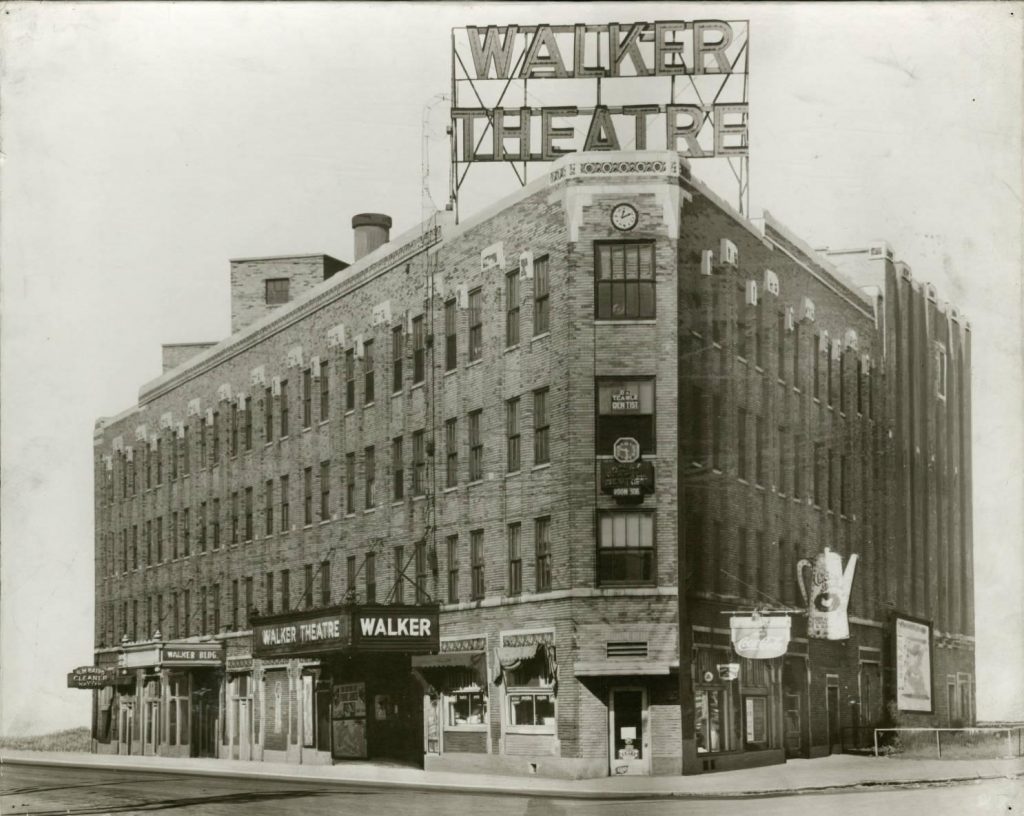
The Walker Building included a theater, drug store, manufacturing company, beauty shop, ballroom, and offices. The building was saved from demolition in the 1970s and was restored in the 1980s. The Walker Building reopened in 1988 as the Madam Walker Urban Life Center and in 1996 the name was changed again to the Madam Walker Theatre Center.
Credit: Madam C.J. Walker Collection, Indiana Historical Society View Source
Reginald DuValle’s Blackbirds orchestra played at the theater’s opening on December 16, 1927, before the silent movie “The Magic Flame.” The theater was built for stage shows, a band in the orchestra pit, and silent movies, covering nearly all of the performance traditions except for talkies, but in June 1929 the Walker began to install talkies technology as well. Eventually, movies began to replace vaudeville shows at the Walker. In July 1938 St. Clair Gibson argued in the pages of the Indianapolis Recorder that the Walker was no longer booking vaudeville acts, complaining that the Theater “refuse[d] to book such nationally-known road shows as Brown Skin Models and Whitman Sisters. … Why can’t we have vaudeville at the Walker?”
Many vaudeville performers continued to perform on the Avenue in the 1930s and 1940s in a host of spaces that emerged in the late 1920s or 1930s. At the end of 1927 Denver Ferguson opened the Rainbow Palm Garden restaurant in the former Liberty Hall building at 427 Indiana Avenue. A December 1927 show at the Palm Garden looked to be continuing the vaudeville tradition: Manuel and Adeline Torres would be providing “their Spanish Hawiian [sic] and Oriental music and dancing … filled with Mythical poetic charm”; Charles Olden would deliver “a dramatic reproduction of the Dope Fiend”; and Olden and Harold Simpson would provide a ukulele duet.
Denver’s brother Sea opened the Trianon Ballroom in December 1931, part of a rapid growth of clubs along the post-Prohibition Avenue. The Trianon featured orchestras and dancing, and Sea’s Cotton Club opened in the floor below the Trianon in October 1933. Denver opened perhaps the Avenue’s most famous club, the Sunset Terrace, in December 1937. The Sunset would attract some of the nation’s most prominent African American performers.
In the second quarter of the 20th century, many venues would become fixtures of Avenue entertainment under a host of names and management. For instance, the Rainbow Palm Garden eventually became the Sky Club. A 1946 program featured a dance team, comedian, blues performer, and exotic dancer appearing alongside the club’s orchestra under the direction of Jimmy Coe. The Flamingo Supper Club opened in December 1957. The Flamingo still preserved some of the traditions of vaudeville, with a tap dancer and exotic dancer appearing in March 1958 alongside Etta James and Indianapolis’ Jimmy Coe.
A series of influential jazz clubs opened in the wake of World War II, and the Avenue was an exceptionally rich hub for music from the war’s end into the 1960s. Henri’s was one such club. A famous plaque over the door proclaimed “Through These Portals Pass the World’s Best Musicians.”
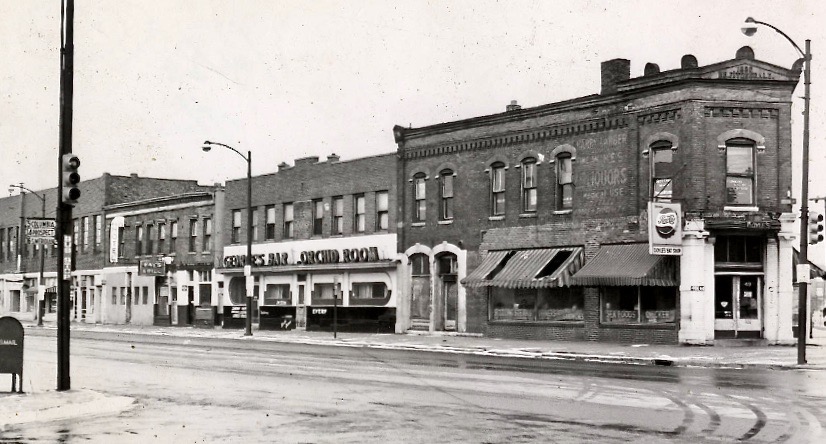
George Reid opened the Orchid Room in 1951. In the 1950s the Orchid Room would host quite a few of Indianapolis’ postwar musicians, including Jimmy Coe, Earl Walker, Erroll Grandy, Willis Kirk, and Wes Montgomery. In 1952 WIBC radio was broadcasting from George’s one night a week, one of a series of postwar Avenue clubs hosting radio shows.
Wes Montgomery
Certainly no Indiana Avenue musician is better known than John Leslie (Wes) Montgomery. Montgomery’s parents, Thomas and Francis, migrated from Georgia to Indianapolis for industrial job opportunities. They were married in 1919 and had five children by 1930. Wes was born in 1923. Thomas and Francis separated in 1930, and Wes moved with his father to Columbus, Ohio.
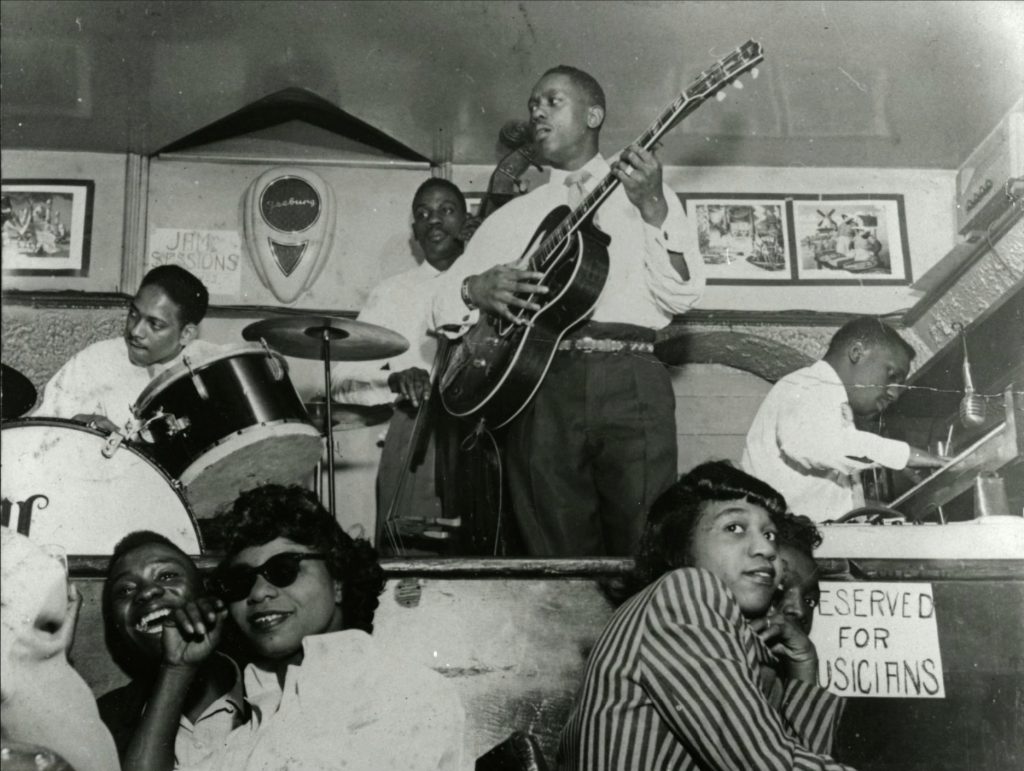
Wes Montgomery returned to Indianapolis in late 1940, and in February 1943 Wes married Serene Miles. Wes Montgomery said in 1961 that he took up guitar when he was 19 years old, saying he first began to play six-string electric guitar “right after I got married.” Wes Montgomery’s first public performances came at the 440 Club at 440 Indiana Avenue. Montgomery remembered in a 1961 interview that he began playing solos by Charlie Christian around 1943, and “about six or eight months after I started playing I had taken all the solos off the record and got a job in a club just playing them. I’d play Charlie Christian’s solos, then lay out. Then a cat heard me and hired me for the Club 440.” In September 1944 Four Kings and a Jack played a show at the Camp Atterbury military base south of Indianapolis, and the band included “Carl Maynard, Jack Bridges, Emerson Senora, Wm. Cox and Wesley Montgomery.” In November 1944 the band played the Rhumboogie club at 536 ½ Indiana Avenue.
Throughout the 1950s, Wes worked at P.R. Mallory and Company and Polk’s Dairy, while he and his brothers played local venues and toured with national acts. His brothers Monk and Buddy were accomplished musicians, playing together as well as in other bands throughout the postwar period. Like Wes several years earlier, Monk began to tour with Lionel Hampton in January 1953, and during that tour Monk began to experiment with the electric bass. The youngest Montgomery brother Buddy first toured in 1948 with a band led by Jimmy Coe. Coe graduated from Crispus Attucks in 1938 and met Wes in about 1945.

Wes Montgomery hagiography typically argues that he was discovered at the Missile Room, a West Street club that opened in May 1958. The club at 518 North West Street did indeed feature Montgomery in its first live shows, and in the audience for one of those shows in September 1958 was saxophonist Julian “Cannonball” Adderley. Riverside Records’ producer Orrin Keepnews later confirmed that Adderley met with him in his New York office on September 17, 1959, and urged Keepnews to sign Montgomery. Montgomery’s first Riverside release was The Wes Montgomery Trio, which was recorded in October 1959 and came out before the end of the year.
Montgomery was a well-established international star by 1967, but he continued to spend time in Indianapolis and perform locally, including a May 1967 show with Cannonball Adderley at the Murat Theatre, and a November 1967 performance with Adderley at Butler University’s Clowes Hall, just blocks from the Montgomery home on West 44th Street. Montgomery was touring at the start of 1968, ending with a show at Caesar’s Forum in Phoenix on June 3-5. Montgomery returned home to Indianapolis in preparation for a busy summer, and he was at his home on West 44th Street on June 15 when he woke up feeling ill. Montgomery collapsed after a heart attack, and at 10:40 AM he was pronounced dead at Methodist Hospital. Montgomery was buried in New Crown Cemetery, where Montgomery’s father Thomas had been buried in 1956.
Playlist: Music of Indiana Avenue
This sample of ten songs features writers and performers prominent in Indiana Avenue’s history spanning 1870 to 1970. Listening notes follow the playlist.
- Carve Dat Possum. This song, published in Boston in 1875, was one of Henry Hart’s best known compositions. It is typical of songs that would have been performed by minstrel companies. This recording is by Harry Clinton Brown, a banjo player and actor who performed in vaudeville and silent movies.
- That Demon Rag! One of Russell Smith’s more popular compositions, this would have been typical of the kind of music performed by Smith’s Orchestra, which included pianist Reginald DuValle. This recording is by Paragon Ragtime Orchestra, a contemporary group that records original orchestral arrangements of rags.
- You Want Lovin’ and I Want Love. This recording by Noble Sissle and his Orchestra represents an early bridge between ragtime, vaudeville, and the new music called “Jazz.” Notice the syncopated sixteenth note rhythms similar to “That Demon Rag!” and the use of the banjo in the rhythm section, which was typical of early jazz.
- The Jumping’ Blues and Sepian Bounce. Jimmy Coe was an arranger and baritone sax player with the Jay McShann orchestra in the early 1940s. Coe arranged both of these pieces for a July 2, 1942 session in New York City. A young Charlie Parker was also featured in McShann’s orchestra. Listen for his solo in Sepian Bounce. Jimmy Coe’s arranging was influenced by Sy Oliver, the prominent arranger and composer for Jimmie Lunceford in the 1930s.
- Green Dolphin Street. Lee Katzman was a sideman for many prominent big bands, including Stan Kenton, from the 1940s on. This session includes Fort Wayne pianist Jack Wilson and Leroy Vinnegar, an Indianapolis bassist who rose to fame in the cool jazz scene of the West Coast.
- Round Midnight. Wes Montgomery’s recording of this Thelonious Monk tune features Melvin Rhyne and Paul Parker, an organist and drummer with whom he frequently worked in Indianapolis. This recording was made in New York City in 1959.
- Groove Yard. This 1961 recording features Wes Montgomery on guitar, Monk Montgomery on bass, and Buddy Montgomery on piano.
- Hub Cap. Larry Ridley is the bassist for this 1961 Freddie Hubbard recording. Ridley would also later tour with Thelonious Monk. This is prominent example of hard bop, a style epitomized by Hubbard after he joined Art Blakey’s Jazz Messengers in 1961. Hubbard grew up in Indianapolis and attended Arsenal Tech High School. Ridley is the nephew of Ben Holliman, one of Indianapolis’ earliest jazz icons.
- Beneficient. Phillip Ranelin was an avant-garde trombonist whose Tribe ensemble merged jazz, soul, and funk. Born in Indianapolis, Ranelin worked mostly in Detroit.
- Ezz-Thetic. This track, from the George Russell album of the same name, features a solo by David Baker. Baker was born in Indianapolis and attended Crispus Attucks High School. He joined George Russell’s avant-garde sextet in the 1960s, which also included legendary saxophone player Eric Dolphy.
Urban Renewal
In November 1936 architect Edward Pierre presented an urban planning initiative known as the “Indianapolis Plan” that started with the bold statement that “America is to be rebuilt. It will be rebuilt wisely or otherwise, but it will be rebuilt.” Indianapolis politicians, planners, and ideologues embraced many commonplace urban renewal schemes including “slum clearance,” municipal housing, highway construction, and residential displacement. These projects transformed much of Indianapolis, and they displaced most of the African American neighborhoods along the Avenue and read the death rites to Indiana Avenue businesses and leisure venues.
Even before the Great Depression, renewal, clearance, and displacement were taking place on the near westside. Indianapolis’ Commercial Club led the planning of a city-wide park system that eventually resulted in the construction of Riverside Park and George Kessler’s 1909 boulevard system. But the Kessler system and Riverside Park did not extend to Indiana Avenue. City Council had determined that the overwhelmingly African American “lands south of Indiana avenue are least likely to advance rapidly in value, and that consequently it will be best to abandon for the present the southern end of the system.”
City Hospital administrators seeking to expand and create park spaces around the hospital displaced neighboring residential communities beginning on the eve of World War I. In August 1917 planning began for the Riley Hospital for Children, and in August 1921 the Indianapolis Times described the proposed tract for the hospital and park adjoining City Hospital and acknowledged “most of it is occupied by small dwellings.” Groundbreaking came in July 1922, and the Hospital was dedicated in October 1924.
Lockefield Gardens
During the Depression, the New Deal funded urban development projects intended to employ workers and address tenement impoverishment. Many social reformers had long imagined urban planning as a mechanism to address tenement impoverishment, and by the Depression most urban transformation projects included the elimination of existing neighborhoods that were overwhelmingly African American communities.
The most significant of those federal projects in Indianapolis was the construction of the Lockefield Garden Apartments. The Public Works Administration (PWA) administered slum clearance and municipal housing (commonly called “public housing”). Between 1934 and 1937 the PWA constructed 51 public housing projects including Lockefield Garden Apartments.
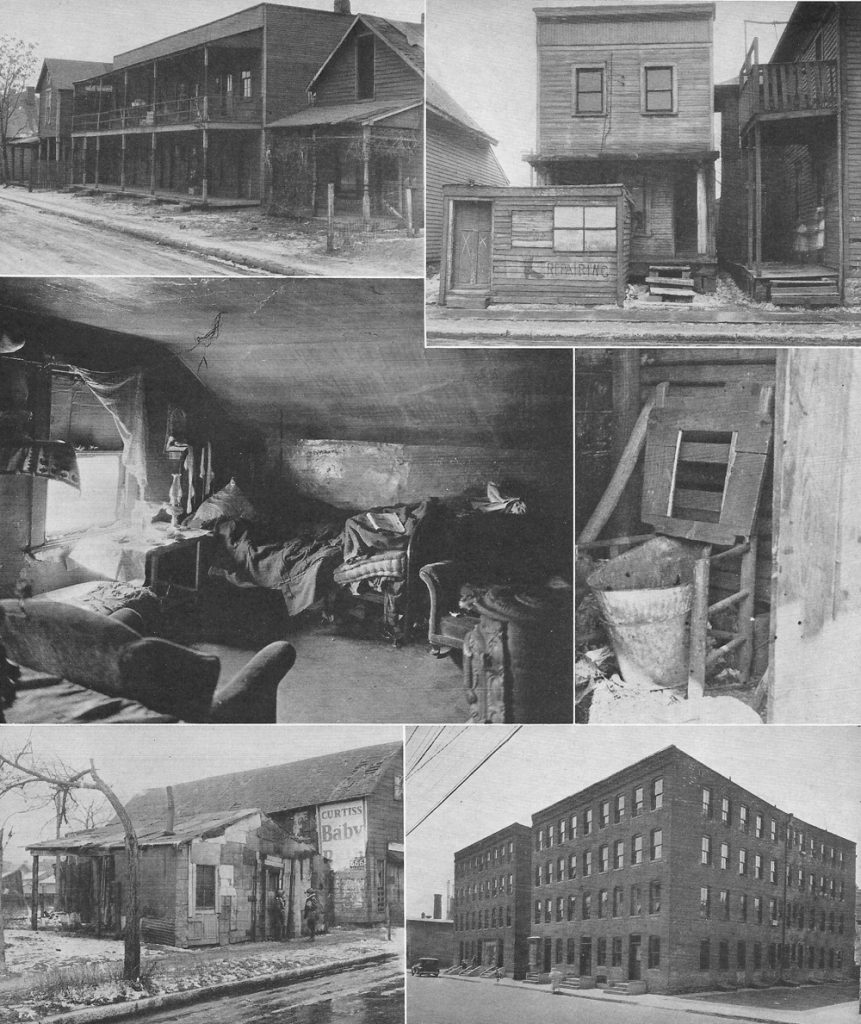
In 1932, federal planners envisioned two segregated housing developments in Indianapolis, with a white development on the near southside and a Black development north of Indiana Avenue. When local funding did not materialize, PWA administrators decided to finance the cost of the project for Black residents and eliminate the project for white residents. They selected a new site south of Indiana Avenue. In October 1934 most if not all of the homes in the Lockefield tract stood empty awaiting demolition, and the first payments for condemned properties were made to residents in late November 1934. Indianapolis architects Merritt Harrison and William Earl Russ developed the 748-unit complex’s design under the supervision of PWA architect Henry Wright, who contributed to the landmark 1932 Museum of Modern Art’s Modern Architecture International Exhibition. In December 1934 an array of local proponents and federal administrators finally gathered for the ceremonial dismantling of a home in the Lockefield Gardens tract. The cornerstone for Lockefield was laid in August 1936.
Lockefield would be the social heart of the neighborhoods along the northwestern end of the Avenue, but it certainly did not resolve housing problems in the African American community. When it began considering who would become its first residents, Lockefield Gardens was inundated with 1700 applications. Residents were selected based on their apparent adherence to middle-class values and a host of “common sense … rules pertaining to their income, character, stability, etc.” By November 1937 the Lockefield administrators had selected 864 families for the community, and in February 1938 George and Edith Martin and their two children became the first family to move into the “group homes” structures on the south side of the development along West North Street.
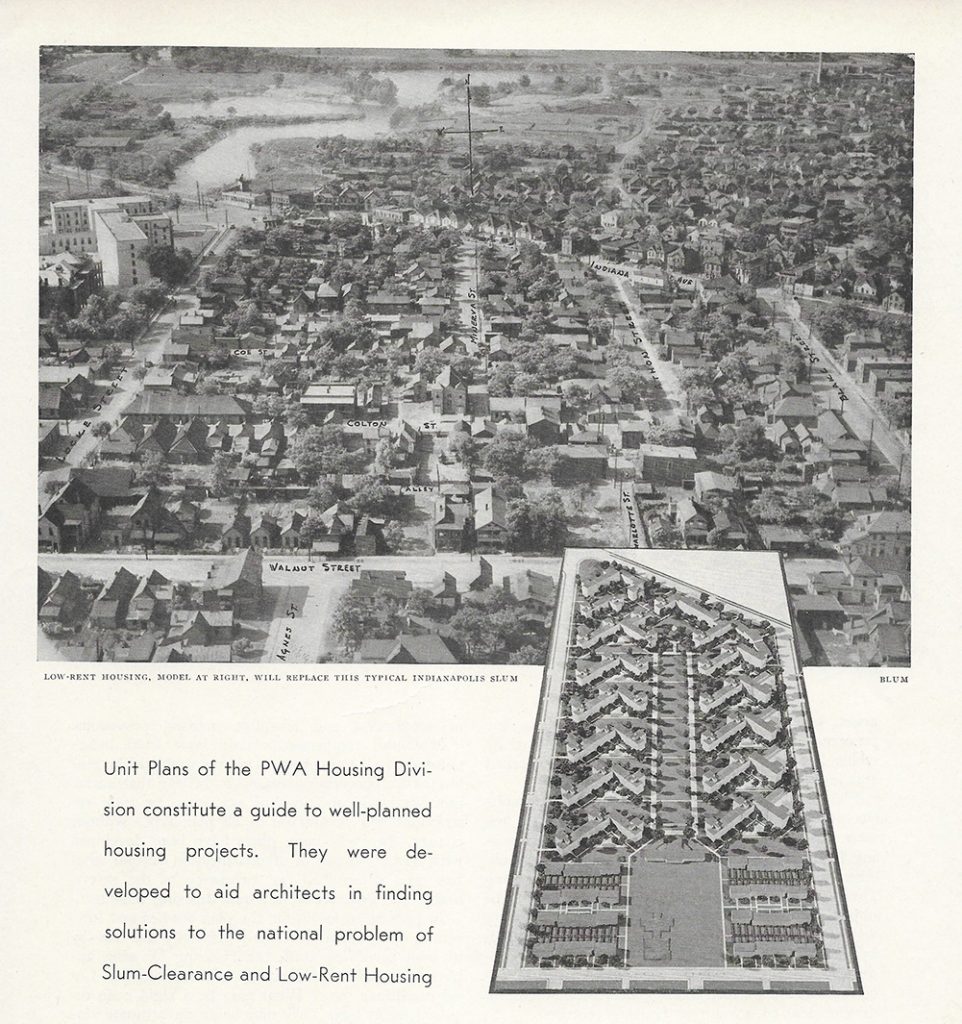
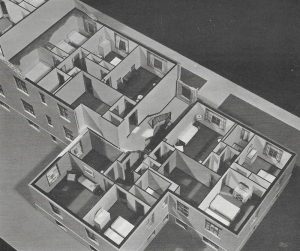
Local realtors and elected officials had aggressively fought the construction of Lockefield. The city’s resistance to municipal housing was driven by an unwavering commitment to laissez-faire development. The city of Indianapolis was equally resistant to assuming administration of Lockefield. The 1937 Wagner Housing Act conveyed management of most municipal housing to local governments, but for more than a decade Indianapolis’ City Council resisted the creation of a local housing authority. In January 1937 construction was not even completed on Lockefield when the Indianapolis Times expressed alarm that “Indianapolis is totally unprepared to take over the Lockefield Gardens project.” In November 1949 an Indianapolis Housing Authority was finally approved, but it would do nearly nothing until the 1960s. The local housing authorities’ disinterest in maintenance of Lockefield would hasten its decline in the 1960s and ensure that the showpiece architectural space would itself be the target of urban renewal advocates just over 30 years after it opened.
Postwar urban renewal
The most significant wave of urban renewal began with the creation of the Indianapolis Redevelopment Commission in 1944, one of scores of local agencies across the country that directed transformations in post-war cities. The first project of the Indianapolis Redevelopment Commission was a proposal to raze an overwhelmingly African American neighborhood in the northwestside and rebuild a portion of the space in partnership with Flanner House. Flanner House was founded in 1898 as a settlement house agency to assist Black newcomers arriving in 19th-century migrations and subsequently in the Great Migration. Cleo Walter Blackburn became the Flanner House director in January 1936 and would orchestrate its ambitious postwar programs, including what became known as Flanner House Homes.
This first Indianapolis Redevelopment Commission project was called Project A, and it targeted a residential area just north of Crispus Attucks High School. A study of the neighborhood by Blackburn concluded that it was “one of the most unsightly, unsanitary, and deteriorated sectors in the entire city of Indianapolis,” and he advised that “immediate steps should be taken by the Indianapolis Redevelopment Commission to declare the area blighted and to acquire, clear, and redevelop it.” Blackburn planned to build “sweat equity” housing in which male heads of households constructed their homes and the homes of their neighbors (women could not participate in home construction). In 1947 Flanner House Homes indicated it planned to focus on the housing of African American veterans and their families.
Construction on Flanner House Homes began in 1950 by a series of men who had been exhaustively reviewed by Flanner House to serve as a model middle-class African American community. By 1953 210 homes had been razed and in 1954 nearly 50 homes were built or under construction. According to Flanner House, 264 families were displaced by Project A.
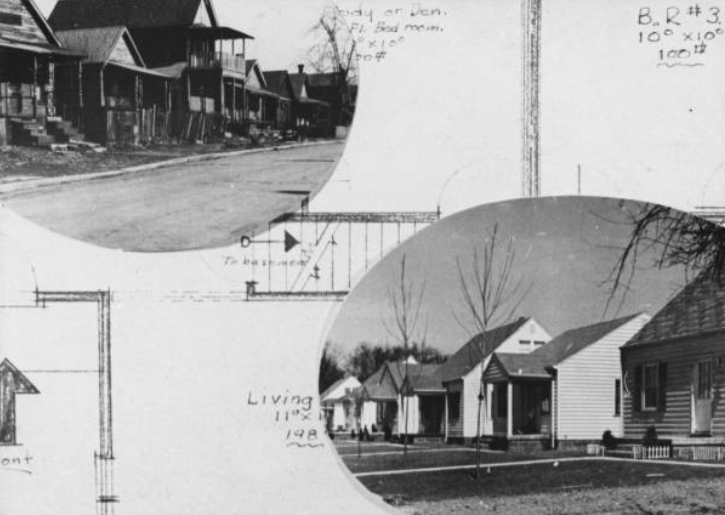
By 1964 the project had built just over 300 homes, and while the city celebrated Flanner House Homes as a success story, it did not remotely address housing problems in Indianapolis. In August 1959 Flanner House’s own Joseph Taylor acknowledged that “We don’t want to attach an exaggerated importance to our work as a solution to the housing problem. … We need 30,000 homes in Indianapolis, and our operations at most would meet less than 2 percent of that.” Flanner House’s segregation ran squarely against anti-racist housing activism, though housing was not legally integrated in federal law until the 1968 Fair Housing Act.
Highway construction
After his election as President in November 1952, Dwight D. Eisenhower became an especially vigorous advocate for the construction of an interstate highway system. The first legislation came in 1956 with the Federal Aid Highway Act, and in October 1957 planners proposed Interstate-65 would run in a route from Chicago to Louisville through Indianapolis. A year later the 1958 Indianapolis’ Central Business District plan imagined Interstate-65 would wind through the near northside and extend south through Fountain Square and the eastern edges of the city. Indiana Avenue sat squarely in the path of one leg of the proposed interstate pathway, which was envisioned running south along West Street.

Public opposition to these plans began early and was centered around displacement and devalued property. One opponent was mayoral candidate John Barton, who advocated eliminating the interstate’s route through the northside. He argued that route would “displace 4,000 to 5,000 residents.” The Indianapolis Recorder reported favorably on Barton’s resistance to the interstate, saying “that if he is elected mayor, he will make every effort to find another route `that would not wreck an entire neighborhood and the social relationships of thousands of people.’”
Allen W. Clowes was the most prominent critics of the proposed interstates. His Golden Hill home was within a quarter mile of the planned interstate route. He opposed the route and advocated for a depressed highway, calling the planned elevated road a “`Chinese wall of dirt’ which will do untold harm to this city’s future.”
Barton was elected mayor in 1964 and formed the Greater Indianapolis Progress Committee in December 1964 (GIPC). “Streets and highways” was one domain that fell within the advisory group’s purview. Clowes appealed to the group to modify the proposed highway plans, but GIPC backed the proposed interstate plan, rejecting Clowes’ case for a different route or a below-grade (a.k.a., “depressed”) interstate. This went against Barton’s campaign pledges, and when Barton ran for reelection, the Indianapolis Recorder and its readers were consistently critical of him. He lost his reelection to Richard Lugar.
In 1966 Representative Andrew Jacobs Jr. introduced the Homes Before Highways bill, which “would prohibit the acquisition of land or construction of public works until adequate and comparable replacement homes and churches are available to the displaced.” In September 1966 supporters of the Homes Before Highways legislation delivered their most unsettling threat when they proposed to hold a march in Indianapolis that would include Martin Luther King Jr. Governor Roger Branigan hoped to avoid a protest led by King and agreed to encourage “more generous settlements for persons dislocated by public improvements,” which included the displacements associated with Indiana University’s property acquisitions. No relocation payments were made before 1967, but Homes Before Highways secured relocation payments to 3,598 households by the Highway Department.
Richard Lugar’s victory over Barton in the 1966 mayoral elections revived hope that a new mayor might lobby the state to re-route or build the interstate below grade. But planning consultants urged the city to continue the present route, and activists largely abandoned efforts to relocate the northwestern leg of the interstate. In July 1969 the highway department indicated that it had purchased 5000 parcels and had only another 50 to secure, and 90 percent of the construction contracts were completed. In January 1972 the final section of I-65 opened.
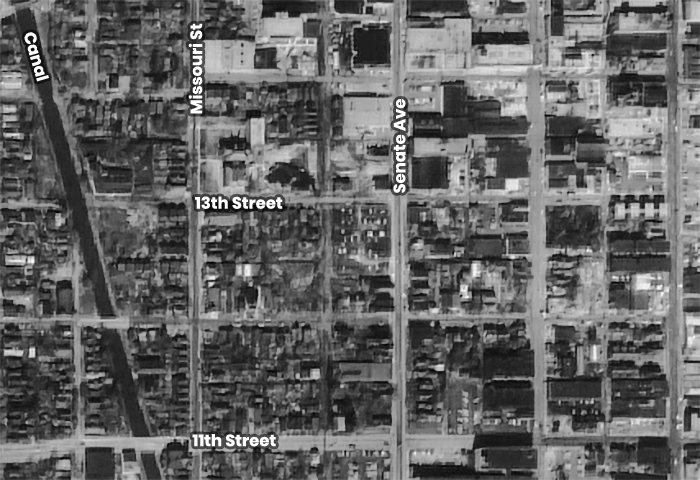
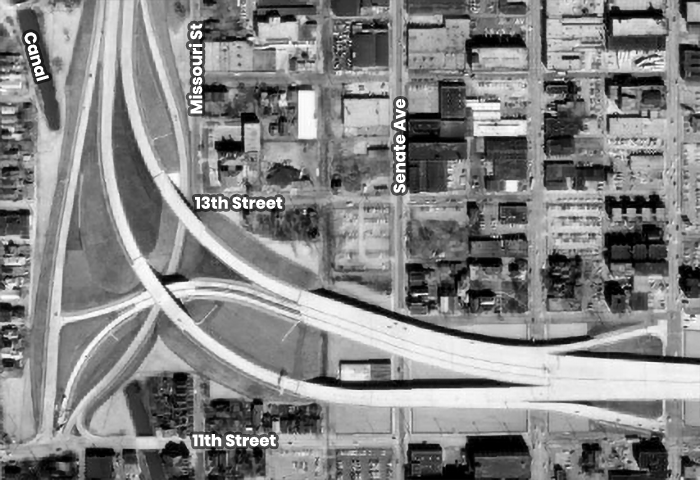
Indiana University
Indiana University had long aspired to expand the Medical Center property around the City Hospital. In 1948 Medical School faculty member Thurman B. Rice frankly predicted growth in the neighborhood of “hospitals, apartment houses, fraternity houses, office buildings and the like. The fact that we are surrounded on all sides by `blighted areas’ gives large room for expansion.”
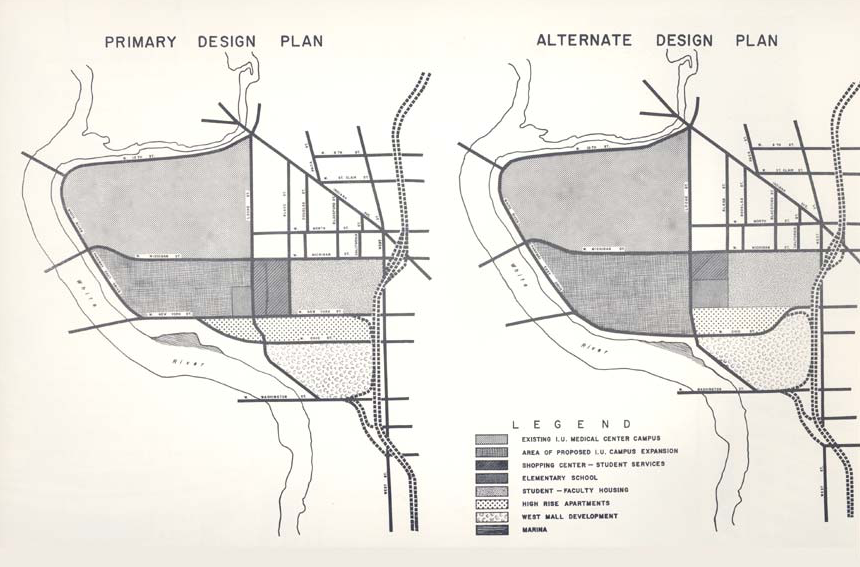
University Trustees approached the Redevelopment Commission with their plans for expansion, asking that the commission “shut out” any new landowners that would “make it more difficult and expensive” for the medical center to expand. The Indianapolis Star recognized the covert effort to “[declare] `blighted’ a run-down area near the center,” but in 1954 and 1956 Projects D and F approved 34 acres for clearance. Tours were even offered of the “blighted” areas, which were home to over 700 residents.
In 1957 the Marion County Department of Metropolitan Planning began to plan space for a university campus south and east of the Indiana University Medical Center. Indiana University and Purdue University each had extensions in the city, but the city had ambitions for a joint undergraduate campus. A 1958 plan proposed the construction of three buildings at the southeast corner of Michigan and Agnes Streets (the latter now University Boulevard) but left most of the residential neighborhoods along Indiana Avenue and south of the Avenue untouched. Nevertheless, IU was quietly purchasing properties in the near westside in the early 1960s.
Plans for university expansion began to materialize in the mid-1960s. In June 1965 the Trustees resolved that the western boundaries of the campus would be at West Street. In August 1966, an alliance of IU, Purdue, the Department of Metropolitan Planning, the Indianapolis Redevelopment Commission, and Community Action Against Poverty hired Victor Gruen and Associates for a six-month design study of what was dubbed the University Quarter district.
Gruen developed a progressive plan for an urban university. His report imagined a landscape in which “the city itself becomes the campus” and course offerings would be directed to residents and focused on the strengths and challenges of urban life. The plan included a pedestrian thoroughfare on Indiana Avenue, up to 10,000 affordable housing units to account for displacement, and integration of the university into the fabric of downtown. Gruen argued against an “island” campus cut off from the city by West Street, but this was eventually what was developed by Indiana University-Purdue University, Indianapolis.
The university gradually pieced together the regional undergraduate campus and much of the Medical Center campus parcel by parcel in the mid-1960s. Purchase of the first Indiana Avenue property may have been in October 1965, when IU purchased Ruth McArthur’s home at 802-810 Indiana Avenue. McArthur founded the McArthur Conservatory of Music at the address in 1946, and the school was a staple of Avenue musical education until its closing in 1963. Renters were often allowed to remain in homes that the University had purchased, and new renters sometimes leased the space until the university was prepared to raze the standing buildings and develop those properties.
In January 1968 community resistance organized around a festival called “Operation Avenue” that would highlight the Avenue’s cultural history and advocate for renewed investment. Mayor Richard Lugar provided lukewarm support for the Avenue collective. He admitted his support for the University plans when he indicated that “the idea would be worthy of his support” but the “plans might conflict with those of I.U. and the Indianapolis Redevelopment Commission.”
University tensions with surrounding residents were heightened by the late 1960s. In March 1967 the Recorder reported, “Westside Improvement Asociation [sic] has charged I.U. with using `scare’ tactics to force Negro residents to move and not funding them fairly for their `valuable’ property.” In March 1968 the Indianapolis Star reported that the “university has been under heavy fire from local architects and planners because, they say…the campus do not fit with the urban environment.”
Plans for the campus that involved IU, Purdue, and city planners continued behind the scenes. In the latter months of 1968, they stalled, largely because of haggling over costs between IU and Purdue. But after Mayor Lugar threatened to establish a new, independent, state university in December 1968, the two university presidents cobbled together a deal that led to a secret merger deal that took effect on January 29, 1969, and Indiana University-Purdue University Indianapolis (IUPUI) was born. Maynard Hine, who had been dean of the Indiana University School of Dentistry was named the unified urban campus’ first chancellor.
Hine created a committee in September 1969 to assess community concerns. The committee reported to Hine in January 1970 that “as social and commercial services disappear from the neighborhood, tenants and homeowners are asking if the City and the University are not making the area so barren that people are forced to move out.” Richard Lugar acknowledged community concern in 1972, saying, “There seem to be rumors semiannually that IPI is going to take over the rest of the neighborhood…The fact that these rumors gain such widespread acceptance indicates that they are real feelings, of residents, and are not fabricated by neighborhood leaders.”
Lockefield Garden, built just three decades earlier, was planned for demolition according to some expansion plans. The university first denied this, saying in 1968 “there is no anticipated expansion plans for the $1 billion University Quarter complex into the area occupied by Lockefield Gardens.” But in February 1977 the city admitted it “wants to tear down the vacated former public housing project and turn the land over to Indiana-Purdue University, Indianapolis, for faculty housing.”
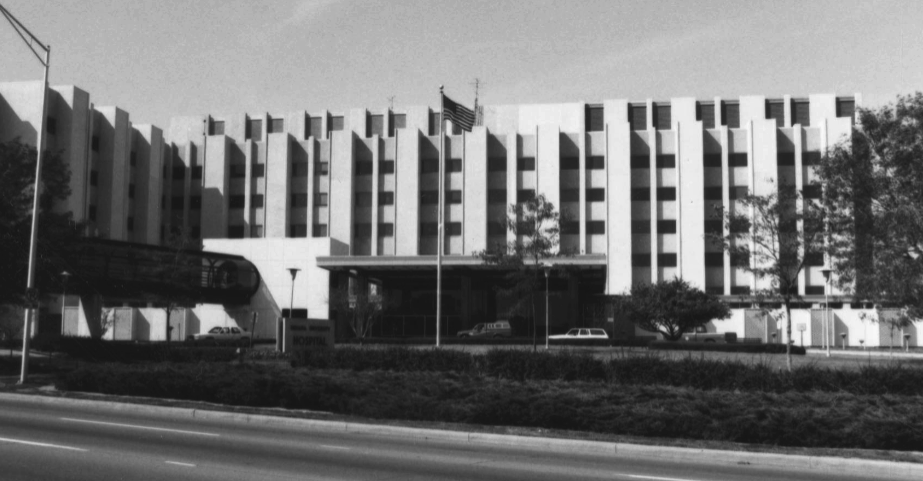
By 1970 Lockefield Gardens had declined in the hands of disinterested city administration, and the Indianapolis Housing Authority sought funding to renovate the community. Lockefield residents voted in April 1971 to approve the renovation plan, which would relocate all residents and called for the removal of seven buildings. The renovation exodus did not begin until May 1973, but in October 1975 Judge S. Hugh Dillin ruled that rehabilitating Lockefield for an exclusively or overwhelmingly Black residency would be an illegal continuation of school segregation. The rehabilitation plans were delayed, and by 1977 the city had resolved to simply raze Lockefield, leading to a flurry of attempts to preserve the New Deal community. In July 1983 all but seven of the Lockefield buildings were razed.
☙
Oral Histories
Oral Histories
These recordings of those who lived on Indiana Avenue provide vivid stories about the community.
Delores Coe. Grew up on Indiana Avenue and married Jimmy Coe, prominent Indianapolis saxophone player and big band arranger. (3 minute listen)
Nancy Johnson. Born on Indiana Avenue in 1921 after her parents moved from Tennessee and Texas. (4 minute listen)
Julian Coleman, who attended Crispus Attucks and whose father taught at the school, discusses Indiana Avenue institutions, segregation, and changes on the Avenue as IUPUI expanded. (5 minute listen)
☙
Scholar of Indiana Avenue
In the first two decades of the 21st century, the heritage of the Avenue received attention in locally produced radio programs and podcasts, such as Echoes Along Indiana Avenue, and in guided tours offered by local public historians. But no one did more to recover and understand the past of this iconic neighborhood than Paul Mullins (Sept. 22, 1962-Apr. 16, 2023).
Born in Williamsburg, Virginia, Mullins graduated from James Madison University, where a summer archaeological dig at Thomas Jefferson’s home, Monticello, helped him discover how understanding the past can help to understand and address current social inequalities. With this inspiration, Mullins earned a PhD from the University of Massachusetts Amherst, in 1996. Three years later, he joined IUPUI as a professor of anthropology, later earning the title of Chancellor’s Professor for his nationally recognized scholarship.
As a historical archaeologist, Mullins studied the intersection of materiality and the color line, focusing on the relationship between racism, consumption, and urban displacement. He made extensive contributions to public scholarship in Indianapolis, illuminating the role that race has played in shaping the modern contours of the city. For more than two decades, Mullins’ research illuminated the history of the vibrant west-side African American residential community that once inhabited the space now occupied by Indiana University, Indianapolis. Largely due to his efforts, historical markers stand in locations of former structures once central to that community. These markers commemorate and uncover the history of the area and reconnect the IUPUI campus to displaced families and their descendants. His research also led the campus to name its buildings in honor of individuals and families who were once the community’s leaders.
In addition to his scholarly publications on the near-west side, Mullins documented other dimensions of African American and neighborhood life in Indianapolis on his blog sites, Archaeology and Material Culture and Invisible Indianapolis. He provided thoroughly researched posts on a range of topics including the erasure of some of the city’s oldest Black churches; the legacy of segregated waterways and swimming pools in Indianapolis; the impact of highway construction and urban renewal on neighborhood destruction; and the environmental consequences of industry on the west side.
Mullins used his research to create social change and to redress racial inequities in Indianapolis. His contributions have been integral to endeavors such as the creation of the revived Madam Walker Legacy Center and the Urban Legacy Lands Initiative, formed to protect, promote, and inform the community about Black history in Indianapolis.
In 2016-2017, Mullins and a colleague, Susan B. Hyatt, were jointly designated the inaugural Charles R. Bantz Chancellor’s Community Fellows for their work uncovering the invisible histories of Indianapolis neighborhoods. In 2022, the Indianapolis City-County Council commended Mullins for his work advancing the public’s understanding of the role these communities played in developing the city.
The IUI University Library maintains a collection of Mullins’ extensive published work and video lectures.
SUSAN B. HYATT (2023)
https://www.tributearchive.com/obituaries/27734429/dr-paul-r-mullins
https://trip.iupui.edu/Scholar-of-the-Month/View-Previous-Scholars/2023/February2023


